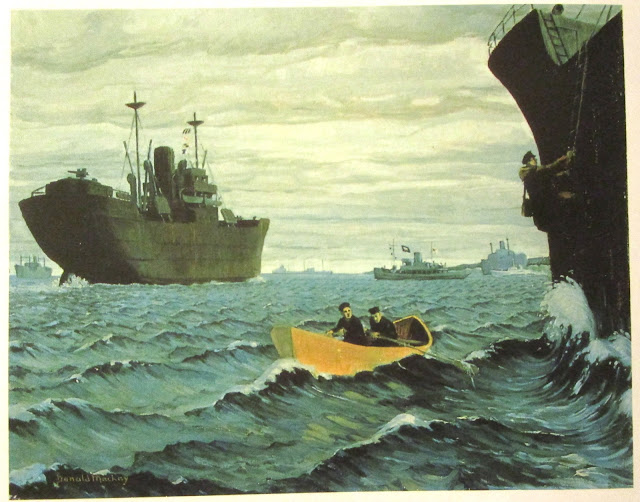READY, AYE, READY
An Illustrated History of the Royal Canadian Navy
By Jack MacBeth
The aforementioned story appears in the book by Jack MacBeth along with many other stories and illustrations that may be of interest to readers searching for more information about the history of Canada's Royal Navy, including details concerning Canada's Royal Navy Volunteer Reserve, the ships upon which Canadians served during WW2, excellent stories and illustrations (including rare paintings and drawings) about Canadian crews on corvettes and other ships, and a few details about the Canadians who served in Combined Operations.
I found my copy on AbeBooks for a decent price and enjoy having it, and others will feel the same. The paintings, illustrations and sketches are excellent and provide a point of view experienced by the 1000 members of Combined Ops at various times in their storied careers. Bold and broken ships are on view and captivating stories by and about our sailors are presented.
A sampling of details and captions that Canadians in Combined Ops could easily identify with in various situations:
Macbeth writes, "As D-Day approached, more than 100 RCN ships joined the massive invasion armada clogging harbours and anchorages all along England's south coast." Among the RCN ships one would see minesweepers, destroyers, corvettes and more, including about 30 LCI(L)s, i.e., Landing Craft, Infantry (Large). Crews were made up of almost 10,000 officers and ratings. Prince David and Prince Henry - two of our country's largest warships (formerly ocean going liners transformed to LCI(L)s) - were included in the armada. Page 126
Please link to the story The Craft of Landing found on Page 130.
Canadian Beach Commandos help unload landing craft on the
beaches of Normandy during the build-up following the D-Day assault.
Photo - Canadian Forces Photographic Unit. Page 131
The hard-luck ship HMCS St. Croix limps into Halifax in December 1941,
damaged by a hurricane. Photo - Maritime Museum of BC. Page 146
"Less than two years later, on September 20, 1943, she was torpedoed and sunk by U-305 south of Iceland."
He reports that 81 men were saved by Itchen, an RN frigate, but all perished - save one - when Itchen was sent to the bottom two days later.
My father, Doug Harrison, writes about meeting the lone survivor while they served at Givenchy III (a Combined Operations training centre) on Vancouver Island, sometime between January 1944 and the summer of 1945.
Note: Other tellings of the tale of the two ships and William Fischer's astonishing survival can be found at The Virtual Museum and at For Posterity's Sake.
A sampling of photos, sketches and paintings one may not find elsewhere:
Please link to Books re Combined Ops - THE CANADIANS IN SICILY and ITALY 1943-1945 (3)
Unattributed Photos GH
Members of the small assault landing craft carried on Prince David,
LCI(L). Combined Ops insignia appears faintly on two sleeves.
Photo - Maritime Museum of British Columbia. Page 66
Assault landing craft coming alongside HMCS Prince Henry during
preparations for Operation DRAGON in the Bay of Naples, August 1944.
Photo - G.A. Milne, National Archives Canada. Page 132
LCI(L) 115, one of 24 landing craft of this type loaned to
Canada by the US Navy expressly for use in the invasion of Normandy.
Photo - Collection of Ken Macpherson, Port Hope, ONT. Page 133
LCI(L). Combined Ops insignia appears faintly on two sleeves.
Photo - Maritime Museum of British Columbia. Page 66
Assault landing craft coming alongside HMCS Prince Henry during
preparations for Operation DRAGON in the Bay of Naples, August 1944.
Photo - G.A. Milne, National Archives Canada. Page 132
LCI(L) 115, one of 24 landing craft of this type loaned to
Canada by the US Navy expressly for use in the invasion of Normandy.
Photo - Collection of Ken Macpherson, Port Hope, ONT. Page 133
'Special Attraction': Sketch by G.S. Bagley.
Photo - Canadian War Museum. Page 83
Photo - Canadian War Museum. Page 83
'Examination Officer Boarding Merchant Ship' by Donald C. Mackay.
Photo - Canadian War Museum. Page 26
Photo - Canadian War Museum. Page 26
I selected the above painting as an example of the fine work found in AYE, READY, AYE because just about every man piloting or travelling aboard a small landing craft would have felt dwarfed by the larger ships in their vicinity.
Recommended.
Please link to Books re Combined Ops - THE CANADIANS IN SICILY and ITALY 1943-1945 (3)
Unattributed Photos GH



No comments:
Post a Comment